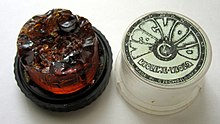
Rosin (/ˈrɒzɪn/), also known as colophony or Greek pitch (Latin: pix graeca), is a solid form of resin obtained from pine trees and other plants, mostly conifers, primarily through heating fresh liquid resin to vaporize the volatile liquid terpene components. Used widely in various industries and arts, rosin appears as a semi-transparent, brittle substance that ranges in color from yellow to black and melts at stove-top temperatures. Rosin consists mainly of resin acids, especially abietic acid,[1] and is soluble in alcohol, ether, benzene and chloroform.
In addition to industrial applications such in as varnishes, adhesives, and sealing wax, it is crucial for musicians who play bowed string instruments to enhance bow grip, and it provides grip in various sports and activities. Rosin also serves as an ingredient in medicinal and pharmaceutical formulations and can cause contact dermatitis or occupational asthma in sensitive individuals. It is an FDA approved food additive.[2]
The name "colophony" originates from colophonia resina, Latin for "resin from Colophon" (Ancient Greek: Κολοφωνία ῥητίνη, romanized: Kolophōnía rhētínē),[3][4] an ancient Ionic city.[5]
- ^ Fiebach, Klemens; Grimm, Dieter (2000). "Resins, Natural". Ullmann's Encyclopedia of Industrial Chemistry. doi:10.1002/14356007.a23_073. ISBN 978-3-527-30673-2.
- ^ Nutrition, Center for Food Safety and Applied (2022-08-25). "Food Additive Status List". FDA.
- ^ Colophon. Charlton T. Lewis and Charles Short. A Latin Dictionary on Perseus Project.
- ^ Κολοφώνιος. Liddell, Henry George; Scott, Robert; A Greek–English Lexicon at the Perseus Project.
- ^ "colophony". Oxford English Dictionary (Online ed.). Oxford University Press. (Subscription or participating institution membership required.) "ad. L. colophōnia (Pliny) for Colophōnia rēsīna resin of Colophon".